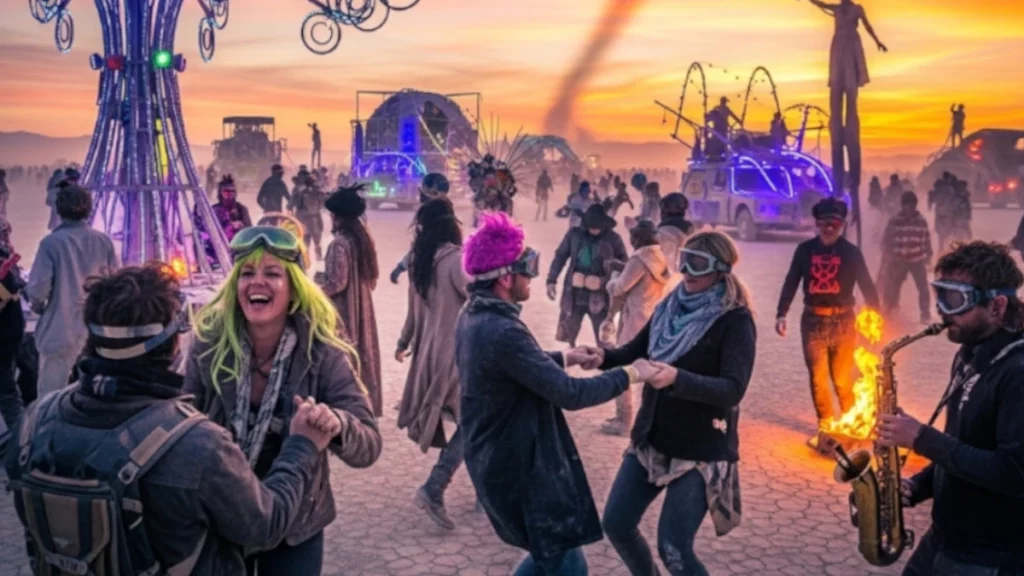Why Fewer People Are Flying to Burning Man This Year—and What That Means for the Festival
Burning Man 2025 is around the corner: in less than a week, the gates will open on Black Rock City, the large temporary city that rises each year from Nevada’s Black Rock Desert.
But as the final preparations are underway, a quiet anxiety has settled over the playa. For the first time in over a decade, Burning Man faces the possibility of not selling out. This signals a deeper shift in economic and social forces that are challenging the very foundation of the event.
The current geopolitical climate in the U.S., combined with the lingering memory of weather disasters from previous editions, has left many wondering whether this year’s festival will look and feel different.
These broader challenges weigh heavily on the minds of participants and organizers alike, raising questions about the resilience and future direction of Burning Man amid a world in flux.

Changing Attendance and Rising Barriers
The concerns that have simmered in online forums and burner communities for months are now more than just talk. International attendance—a key pillar of the community—is down significantly. For years, Burning Man has been a global magnet, drawing tens of thousands from around the world to its iconic desert gathering.
This year, however, these numbers have dropped sharply, leaving both seasoned attendees and organizers uneasy about what this decline means for the festival’s diversity and vibrancy.
Online discussions on Reddit, Facebook groups, and dedicated burner forums are filled with shared frustrations and reflections. Many international burners point to the soaring cost of airfare and complicated logistics as major barriers.
Flights into Reno or San Francisco, the nearest major airports, have become significantly more expensive amid ongoing inflation, making the pilgrimage harder to afford.
Beyond travel prices, the expense of shipping gear and supplies into the remote desert setting has also escalated sharply.
Compounding these financial pressures are tougher travel restrictions and geopolitical tensions.
The increased role of ICE (U.S. Immigration and Customs Enforcement) in airport and border enforcement has introduced new layers of scrutiny for many international attendees.
Heightened visa controls and more rigorous customs inspections have made crossing into the country more cumbersome, adding bureaucratic hurdles that were much less pronounced just a few years ago. For many, these immigration hurdles have forced last-minute changes—or outright cancellations—of their Burning Man plans.
All these factors are putting Burning Man’s foundational principle of “Radical Inclusion” to the test. While the festival promises a welcoming space for anyone wishing to join, rising financial costs and stricter bureaucratic demands risk turning that promise into an exclusive reality.
For those traveling from abroad or coming from less affluent backgrounds, the event is becoming harder to access. What was once a cultural pilgrimage has turned into a complex—and often costly—logistical challenge.
The Tomorrow of Burning Man
The event’s theme this year, “Tomorrow Today,” feels particularly relevant. It calls on attendees to imagine and build a better future, but the immediate challenges of the present world are hard to ignore.

Burning Man has always balanced its counter-cultural roots with the reality of organizing a massive, complex temporary city. Now, these tensions are complicated further by the uneven global economy.
For the thousands already on the playa setting up camps and art, or preparing to arrive, the external pressures fade into the background. The principles of “Radical Self-Reliance” and “Communal Effort” are front and center.
The focus has shifted away from spectacle and hype—what some call the “funflation” of recent years—toward a more grounded and essential experience of community and creativity.
The 2025 event will likely be smaller than in previous years, but it may also be more intentional. With an official emphasis on sustainability and a return to simplicity, organizers and participants are recommitting to Burning Man’s core principles.
That said, the financial and social challenges have forced the community to confront its values and rethink what it wants to become.
As final preparations continue, the future of Burning Man feels more like an unfolding experiment than ever before. This once extraordinary city, founded on principles of gifting, creativity, and community, faces significant financial challenges that will test its resilience.
With so much uncertainty, the world is watching closely to see if Burning Man can not only survive but continue to inspire and evolve.
Blast from the past: Everything That Went Wrong With Burning Man 2023, So Far
Sandboarding Locations Worldwide
Sandsports

Cheri Sanders is an Arizona native, writer, and outdoor enthusiast who believes the best things in life are found off the beaten path—often with her dogs right beside her. Specializing in travel, outdoors, and beauty, Cheri chronicles the adventures of hiking the Southwest and beyond.


